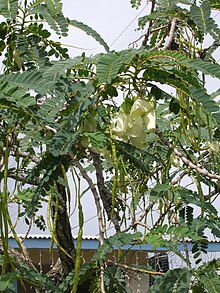Sesbania grandiflora
Species of legume From Wikipedia, the free encyclopedia
Species of legume From Wikipedia, the free encyclopedia
Sesbania grandiflora,[2][page needed] commonly known as vegetable hummingbird,[3] katurai, agati, or West Indian pea, is a small leguminous tree native to Maritime Southeast Asia and Northern Australia. The flowers are commonly eaten in Southeast and South Asia.
| Sesbania grandiflora | |
|---|---|
 | |
| Scientific classification | |
| Kingdom: | Plantae |
| Clade: | Tracheophytes |
| Clade: | Angiosperms |
| Clade: | Eudicots |
| Clade: | Rosids |
| Order: | Fabales |
| Family: | Fabaceae |
| Subfamily: | Faboideae |
| Clade: | Robinioids |
| Tribe: | Sesbanieae |
| Genus: | Sesbania |
| Species: | S. grandiflora |
| Binomial name | |
| Sesbania grandiflora | |
| Synonyms[1] | |
|
List
| |

Sesbania grandiflora is a fast-growing tree. The leaves are regular and rounded and the flowers white, red or pink. The fruits look like flat, long, thin green beans. The tree thrives under full exposure to sunshine and is extremely frost sensitive.
It is a small soft wooded tree up to 5–25 m (16–82 ft) tall. Leaves are 15–30 cm (6–12 in) long, with leaflets in 10–20 pairs or more and an odd one. Flowers are oblong, 1.5–10 cm (1–4 in) long in lax, with two to four flower racemes. The calyx is campanulate and shallowly two-lipped. Pods are slender, falcate or straight, and 30–45 cm (12–18 in) long, with a thick suture and approximately 30 seeds 8 mm (0.3 in) in size.
It is native to Maritime Southeast Asia (Malaysia, Indonesia, Philippines, Brunei) to Northern Australia, and is cultivated in many parts of South India and Sri Lanka. It has many traditional uses.[4] It grows where there is good soil and a hot, humid climate.
Feed from the plant can be deadly to chickens.[5]

S. grandiflora flowers are 92% water, 7% carbohydrates, 1% protein, and contain no fat.[6] In a reference amount of 100 grams (3.5 oz), the flowers supply 27 calories, and are a rich source of vitamin C (88% of the Daily Value, DV) and folate (26% DV).[6]
The flowers of S. grandiflora are eaten as a vegetable in Southeast Asia,[7] including Java and Lombok in Indonesia, the Ilocos Region of the Philippines, Vietnam, Laos, and Thailand.[citation needed] In the Thai language, the flowers are called ดอกแค (dok khae) and are used in the cuisine both cooked in curries, such as kaeng som and kaeng khae, and raw or blanched with nam phrik.[8] The flowers are also prominantly used in Cambodian cuisine and are associated with the Bon Om Touk. The flower's stamen is generally discarded before use. In addition to raw and blanched, the flowers can also be battered and deep fried.[7]
The leaves are also edible.[9] The leaves are eaten young. The seed pods are also consumed, similarly only when young.[7]
The leaves are sometimes available commercially but flowers and seed pods come primarily from kitchen gardens.[7]
It is used to make highly nutritional fodder for ruminants like cattle (but is deadly to chickens).[5]
Seamless Wikipedia browsing. On steroids.
Every time you click a link to Wikipedia, Wiktionary or Wikiquote in your browser's search results, it will show the modern Wikiwand interface.
Wikiwand extension is a five stars, simple, with minimum permission required to keep your browsing private, safe and transparent.